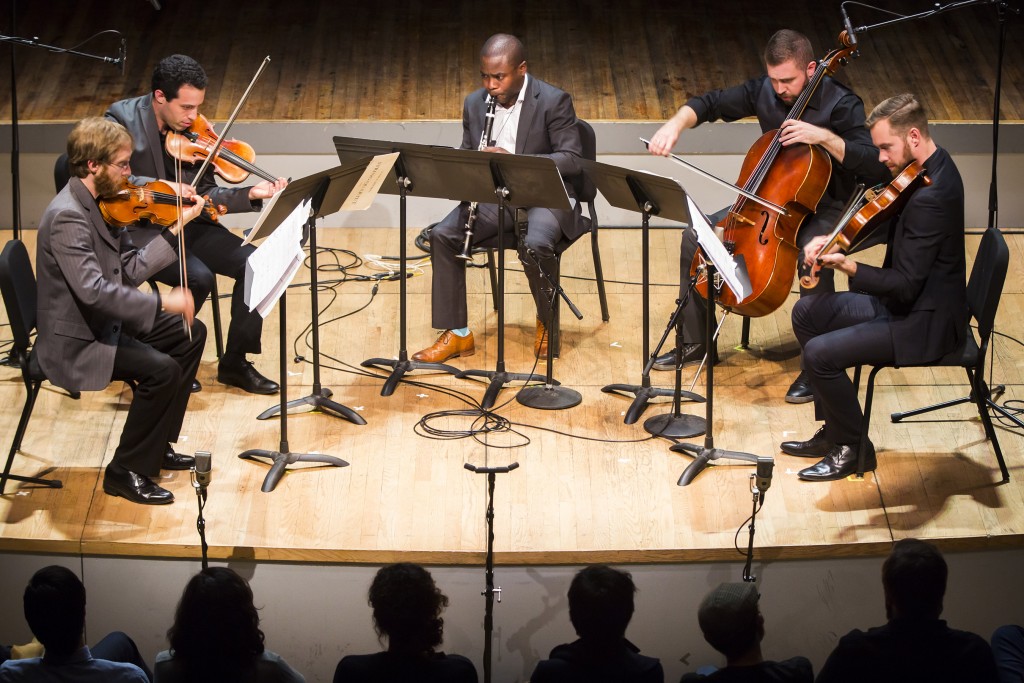JACK Quartet and Anthony McGill serve up American music spanning 65 years

JACK Quartet and Anthony McGill performed the world premiere of Geoffrey Gordon’s Clarinet Quintet Friday night at Roulette. Photo by Chris Lee
Founded in 2014 by Chicago-based music critic and editor of the Classical Review websites, Lawrence A. Johnson, the American Music Project is dedicated to, well, American classical music—both past and present—and to spawning new works.
The nonprofit foundation’s inaugural commission was a Piano Quintet from Amy Wurtz, which debuted in Chicago last October. The 2015 commission, given its world premiere at Roulette Friday night by clarinetist Anthony McGill and the JACK Quartet, is by Geoffrey Gordon. (The work will be repeated on March 6, 2016, at Ganz Hall in Chicago.) And I doubt Gordon or anyone present would complain with the luxury casting: McGill is now principal clarinet with the New York Philharmonic, and the JACK players are at the top of their game.
Gordon’s Clarinet Quintet is in four movements. In the first section, a clarinet trill emerges from a dense cluster chord by the quartet, but eventually gallops free with a trill-infused line, which eventually makes its way to the strings. A frenzied vivace tempo ends in a fortissimo blaze.
In the second section, sustained string chords set the backdrop for the clarinet weaving in and out, as the texture begins to accelerate to Shostakovich-like proportions (one of the few loud sequences in a relatively quiet evening). As the clarinet’s trills return, the movement quietly ascends to land on an ecstatic high chord.
In the third movement, the clarinet dances with each of the instruments in turn, starting with the cello. For a good two minutes, it was a joy just to hear McGill and Kevin McFarland interacting with each other, followed by a beautiful duet with McGill and violist John Pickford Richards, and finally, a trio with the two violinists, Christopher Otto and Ari Streisfeld. When the strings finally converged—the clarinet soaring over their sizzling rhythmic accents—it was only briefly, before the movement ended in a flash.
A virtuoso clarinet cadenza opens the finale, showcasing McGill’s fabulous technique and liquid tone. The strings burst in, as if trying to stop the clarinet’s exhortations, but only briefly before the piece ends. If the roughly half-hour work seemed slightly too long, this was after a single hearing, and as is often the case, I’d like to hear it again—especially by these forces.
Three classics—one recent, two not-so—rounded out the program, starting with John Luther Adams’s The Wind in High Places (2011). With the composer in attendance, the JACK players created magic from the composer’s harmonics and arpeggios. A great piece is more than the sum of its parts, and Adams has made a transparent miniature, a little jewel compared to his more lengthy percussion and orchestral works (Inuksuit, Become Ocean).
One of my fond early music memories was discovering Earle Brown’s Available Forms 1, on a vintage RCA Victor LP with the Rome Symphony Orchestra led by Bruno Maderna, and one of my first encounters with orchestral music incorporating improvisation. In his String Quartet (1965), Brown writes that he “fixed the over-all form but have left areas of flexibility within the inner structures.” The smorgasbord of string techniques deployed is consistently engrossing, starting with the ultra-quiet opening cluster chord, and including percussive pizzicatos done on the other side—the short ends—of the instruments’ bridges. Here the JACK foursome found luxurious sonorities in a work that has a reputation for being a fearsome example of 1960s knottiness.
As is often the case in John Cage’s oeuvre, numbers figure prominently in his String Quartet in Four Parts (1950), which uses an elaborate rhythmic scheme based on the number “22.” As explained in David Wright’s detailed program notes, the entire work totals 484 bars, or 22 times 22, and each movement is a product of twenty-two.
But never mind all of that. What results is a quietly expressive antonym to the Brown (and written 15 years earlier), filled with hymn-like richness, perhaps with a bit of Charles Ives-ian serendipity. The third movement, marked “Nearly stationary,” emphasizes the lack of vibrato, which imparts a feeling of simplicity and contemplation, helped by the JACK players’ sensitivity and understatement. But it is the finale, “Quodlibet,” which is the most startling, evoking the plaintive strains of John Dowland—as if the Renaissance were vaulting into the twentieth century.
The program will be repeated 2 p.m. March 6, 2016 at Ganz Hall in Chicago. americanmusicproject.net
New York-based writer and editor Bruce Hodges is a regular contributor to The Strad, and serves as North American editor for Seen and Heard International (London). From 2007-2015 he was a monthly columnist for The Juilliard Journal, and he has also written for Playbill and Strings magazine. He is currently working on program notes for upcoming concerts at the Southbank Centre in London. Twitter: @BruceHodgesNY